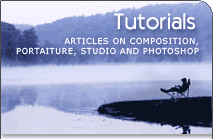Top Rated Tutorials
Three Main Rules
 (29)
(29) 
By reading this article you will learn how to create a photograph (in general terms). There are three main things: theme, focusing attention and simplicity. You will find out what those things mean to you and to the photograph.
Composing The Frame
 (36)
(36) 
In this article I will try to describe numerous techniques to compose a good picture. Some of these techniques are well known (e.g. rule of thirds), some based on graphics of design and painting. I consider the techniques as jongleur balls. The more balls you hold in air (handle), the better pictures you create.
Basic Studio Lighting
 (50)
(50) 
If you are just trying to grasp the basics of Portraiture and want to learn about basic lighting setups, then you would benefit from reading of this article. Here you will find a few diagrams of lighting setups with description of basic light sources.
Facial Analysis In Fine Portraiture
 (41)
(41) 
Consumers come to the professional and plunk down their hard earned money when they want or need something special - something that they can't do themselves - create a truly flattering, aesthetically pleasing image - devoid of flaws and "defects" or shall we say, an idealization and realization of their self image that still looks natural. Having these corrective skills will increase you sales and bring you many referrals. It's a simple marketing matter - most people do not like bad pictures of themselves and will spend good money to have good ones made.
Portrait Lights
 (46)
(46) 
There are not that many different kinds of lights in Portraiture, but you have to know them and the effects they create in your photograph. This article will help you to learn about types of lights and how the could be used.
Wedding Photography - Lessons Learned
 (127)
(127) 
After successfully finishing several wedding photography assignments I learned a few valuable things, which I am going to share in this article. Here you will find out what the guiding list of shots to consider while doing wedding photography and how to be better prepared to the wedding day. In addition to that I want to share some ways that helped me to produce better photographs and finally made my clients happy. This article though is more about photography techniques, not the business ones. And I should add that the article mostly regards to the photojournalistic style of the wedding photography, when the photographer is transparent and unobtrusive.
Reflectors Vs. Flash
 (5)
(5) 
To produce good lighting outdoors photographers use various light modifiers, such as reflectors, diffusion panels, scrims and blockers. Some of these modifiers require a certain effort to set up and carry. The pros and cons of reflectors and flash in wedding photography are discussed by Ed Shapiro on this page
There are GELS and then there GELS!
 (3)
(3) 
Optical filters are for use over the camera lens and are usually made of optical glass, optical grade plastic or gelatine, hence the nickname gel. And on this page Ed explains how the gels are used in photography.
Before Pressing The Button
 (8)
(8) 
Here I will summarize what I found out in forums and other sources about details to keep in mind when you are creating a portrait.
Gobos and Flags
 (5)
(5) 
These are used to block or subtract light unlike reflectors and modifiers that spread or add light. �Gobo� comes from the old cinematographer's term - short for go-between. Experienced portraitists call them head-screens in that they use them to selectively shade areas like bald heads. They can be used like barn doors but they are more mobile. Read more in the article.
